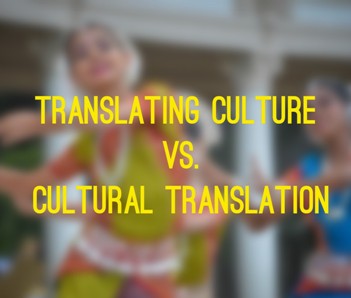Click below icon to Subscribe to Modlingua Channel
Research
- posted by: Ravi Kumar
-
Hits: 4281
By Ravi Kumar
 Harish Trivedi, Professor at the University of Delhi, highly appreciates the fact that over last two or three decades, translation and translation studies have become more visible, more prolific and more respectable activity than ever before.
Harish Trivedi, Professor at the University of Delhi, highly appreciates the fact that over last two or three decades, translation and translation studies have become more visible, more prolific and more respectable activity than ever before.
Trivedi further links this discipline with post-colonial studies that emerged as an area of studies just a few years before translation studies and both have them have become interactive to each through a series of books in this direction, eg. Siting Translation: History, Poststructuralism and the Colonial Context (1992) by Tejaswini Niranjana, The Poetics of Imperialism: Translation and Colonization from The Tempest to Tarzan (1997) by Eric Cheyfitz, Translation and Empire: Postcolonial Theories Explained (1997) by Douglas Robinson, and Postcolonial Translation: Theory and Practice (1999), a collection of essays edited by Susan Bassnett and Harish Trivedi etc.
Before new development took place, translation remained confined to two different subjects or discipline: linguistics and comparative literature, and remained restricted to the substitution of a text in one language for a text in another. But shortly after, it began to be noticed that literary texts were constituted not primarily of language but in fact of culture, language being in effect a vehicle of culture.
Trivedi recognizes that interaction of language with culture helped translation studies expand its horizons and revitalize the discipline. This helped liberate it from the completely mechanical tool of analysis available in linguistics. The words which proved intractable are often described as being culture specific. For example, words like kurta, dhoti, roti, loochi, dharma, karma, or maya etc. began to be treated as specific cultural elements very different from their corresponding western near equivalence shirt, trouser, bread, religion, deeds both past and present, or illusion respectively. Slowly not only some words were taken as culture-specific but indeed the whole language became specific to the particular culture it belonged to.
Trivedi refers to Susan Bassnett and Andre Lefevere who added a cultural dimension to translation studies through their title, ‘the cultural turn in translation studies’ in their book – Translation History and Culture (1990). Trivedi further explains it was Susan Bassnett who declared the death of comparative literature in wake of gaining popularity of postcolonial literature.
Trivedi is concerned with the fact that in parallel there has been the growth of Culture Studies – from Eurocentric beginning to International stature- which is like translation studies is interdisciplinary in nature, but of them have failed to interact properly. Susan Bassnett did propose a four-point agenda: the way in which different culture construct their images of writers and texts, a tracking of the ways in which text become cultural capital across cultural boundaries, and an exploration of the politics of translation, especially of what Lawerence Venuti has called, “ethnocentric violence of translation”, and pooling of the resources.
Trivedi is disappointed with the fact that the cultural turn in translation and culture studies have not come to terms together, maybe because of the fact that translation deals at least between two languages whereas culture studies deal only in one language mainly English. Hence it remains an unfulfilled desire.
Trivedi further moves on to yet another discipline called, “Cultural Translation”. This may not be confused with an old-fashioned sense of translation that involves domestication of text from source to target language. This sort of cultural translation is yet to find its entry in the encyclopedia and anthologies of translation studies, and that this sort of Cultural translation is a dangerous trend that promotes monolingualism, monoculturalism and wants to convert multicultural and diversified world to a monolithic world.
Trivedi sites some examples of this postcolonial and postmodernist discourse and refers to Homi Bhabha who promotes this trend. Trivedi is critical of Bhabha who in his book, “The Location of Culture (1994)” discusses Salman Rushdie’s novel “Satanic Verses” as an example of cultural translation, in spite of the fact that this mentioned book is written originally in English and read in that language only ( not in any other translation). Trivedi calls it a representation of postcolonial diaspora, and what Bhaba is talking about is “Transnational as Translational”. Trivedi rejects this concept and suggests for use of another word in place of translation. It is not a translation, it is a process of human migrancy.
Trivedi further sites examples of Hanif Kureishi, a writer born in England with one British and one Indian/Pakistani parents. He has nothing to do with immigrant population as he is by birth British, but he writes on new British immigrant’s communities because he is being paid for it. Thus Trivedi rejects Bhabha claim that cultural translation is the need of immigrant population, and asserts that such works are hegemonic western demand and necessity.
Trivedi further sites examples of Jhumpa Lahiri, who was born of Bengali parents in London, grew in America to become an American citizen at age of 18. She has written fiction not about Indians in America, but also some stories about Indians still living in India. She has been criticized for having reflected an erroneous and defective understanding of India. She admits that her knowledge of India is limited- the same way- all translations are defective, thus her representation of India is her translation of India. She further elaborates that almost all her characters are translators, insofar as they must make sense to the foreign to survive.
Trivedi is very much worried about the use of the word translation with cultural translation as it dilutes the discipline of translation studies. Therefore, he calls for use of other words like migrancy, exile or diaspora with culture to describe such phenomenon, but not the “Translation”.
Trivedi is worried over Susan Bassnett’s statement on Edwin Gentzler’s book, “Contemporary Translation Theories” where she says, “… the book is not only a critical survey but effectively also a translation, it transforms a whole range of complex theoretical material into accessible language”. Trivedi puts his concern by saying, “it is the same language as English, in which such theoretical complexity and such accessibility both exist”.
Thus we notice that Trivedi ‘s concern on dilution of the word ‘translation’ with the monolingual cultural interpretation of migrant population is quite genuine and that a careful approach is needed to tackle such dilution process that aims to bury multilingualism, multiculturalism and diversity of culture in name of cultural translation.
- posted by: Gautam vasisth
-
Hits: 2491
By Gautam Vasisth (Russian language summer Intern 2018)
This text is the Creative Summary of the Video Lecture presented by Prof. Ravi Kumar, Our Program Director of Modlingua Summer Internship 2018.
Remember when our parents or teachers used to scold us and tell us, “once you go out of the classroom, you will know the world “.. yeah, frankly speaking, language market is totally different from a language classroom. Since we have already equipped ourselves with classroom learning of a language, we better equip ourselves with the basic survival skills of the professional market where competition plays its own role. Many times they assume cruel role because of cut-throat competition and human desire to acquire and amass wealth in excess. Yes, please note, “markets are more cruel for those who lack skills'. So in this internship program, our focus is to build on certain survival skills among the interns so that when they start interacting with the professional world, they are able to cope up well and slowly build on their own strengths in the profession and slowly diversify into a power center of knowledge and skills not only in languages but also in managerial and other related areas.
In order to achieve above objectives, it is mandatory to build on non-linguistic skills that are linked with management of problems and development of critical thinking.
Of course, as said already, we are not discussing the academic or technical requirements of translation of texts that we have already covered in our academic curriculum. Here we are discussing the market approach and management of grievances and professional problems that we generally face while at work.
Modlingua's summer internship program has a great deal of uniqueness. To our knowledge, such kind of training and internship has not be provided so far in any other corner of the world. Modlingua's research and development team has developed an integrated model of learning through practising. Means all interns are trained while on the job. They are allowed to make mistakes and learn from those mistakes. Members of Senior Management provide feedback and train the interns as per their orientation.
Being one of those social ventures which allow connecting the pre-existing big names of this industry and Modlingua has certainly achieved high brand value for being a socially responsible company. It has done a lot to facilitate professional development of language experts, translators, interpreters, teachers and content writers. In order to achieve its vision, Modlingua and its management has launched Entrepreneur Development Centre (EDCenter) that has been continuously working in the field of research, development, innovation and publication. In the past, Modlingua has already published some valuable books in translation studies. They are, Role of Translation in Nation Building; The Joy of Translating Indian Literature; Machine Tools and Translation; Translation Processes. Such important books were published as a result of the deliberations and extremely strenuous efforts of linguists and researchers who contributed their efforts for a common cause.
Here in our summer internship, Modlingua gives a second life to the students who did not get the change during their college time to convert their learning into practice. The reality is the practical training not one thing or something rather it is everything for a professional. If this element is not integrated in the training program, one takes years to fill those gaps and suffers a lot in the job market. So keeping that in mind, we are trying to learn some basic skills as such- “how to brand yourself”? “how to develop professional and corporate skills?
The focus is on the following: project management, quality management, documentation, contractual documentation, social media marketing and entrepreneurial ventures.
Apart from all these, we feel highly motivated to share our knowledge and experience with the interns and help them in understanding the expectations of the clients and how to fulfil their requirements or how to make out if the client is trustworthy? Or how to filter out the bad or fake clients? etc.
Thus, the focus, as mentioned earlier will be on learning how to put our theoretical knowledge into practice. We have a golden rule at Modlingua “whatever we discuss, we practice it". And this we have learnt over a period of twenty years while interacting and providing training to more than two thousand managers whom we have groomed in languages, cross-cultural management, research and business communication.
Another aspect is that of power relations. The world runs around power relations.” Knowing is owning “ so when we say about the knowledge we don’t just mean a particular language but also a set of skills to get into a workplace environment and acquire the knowledge of the work enabling oneself with the other aspects of working verticals. Like if you know Spanish but you also know the skill to communicate with humility and elegance or confidence this adds more value in a supply chain, resulting in a better bargain and thus a better salary!
In any social setup, be it an office or family there’s is a power relation working. Those who have more knowledge, experience and skill sets negotiate a better deal in the bargain. Thus, our interns must acquire knowledge, put them in practice and evolve into a skillful workforce in order to get good figures of income, perk, salary, deals and a bigger cake in the supply chain.
So, basically in this internship program, our focus will be to upgrade ourselves technically, technologically, professionally and above and all as a passionate human being who is ready to contribute value to self as well as to the society as a whole. Also, we would like to see some of the interns take up entrepreneurial ventures by bringing the shift in the mindset of being a job seeker to a job enabler.
Lets learn and grow together.
Do take advantage of this internship program and stick to its motto of bringing improvement in self on a daily basis.
A bright future awaits you at Modlingua Internship 2018.
- posted by: Ravi Kumar
-
Hits: 3256
As we all know, social media platforms have evolved from mere chit-chat activities to full-fledged collaborative platforms. They help us in increasing connectivity seamlessly. Thus they are now being integrated with the activities related to office management, sales management, project management and teamwork. They are one the best possible options for collaborative platforms as one does not have to invest too much in developing and getting proprietory of such platforms. They are free and used by billions of people across the globe.
The management team of Modlingua has taken a pro-active role in using some of the selected social media platforms that have helped its team in managing more than 150 interns in a single batch. They not only use these platforms for communication, but they also use them for effective delivery of projects and tasks assigned and foster cooperation, collaboration, teamwork and diversity and brainstorming at work.
Following are a few of the platforms that keep all 150 interns directly connected with Senior Management and collaborate and communicate with each other. Through these, Modlingua Summer Internship program has become operational 24x7 hours in almost all time zone of the world.
- WHATSAPP BROADCAST GROUP: It is designed to get all regular updates and have one-to-one interaction with the management, bring up problems and get solutions.
- FACEBOOK INTERN GROUP: This closed Facebook group is designed specifically for MODLINGUA interns 2018 to interact and communicate with each other, help each other and collaborate.
- MODLINGUA TRANSLATORS AND INTERPRETERS COMMUNITY AT FACEBOOK: It is a community of language professionals that currently has more than 14000 members from across the globe. Interns find it useful to connect with the experienced professionals and learn from their experience and wisdom. LinkedIn: Interns can connect with each other and become a part of the professional and formal community and get more insight into translation business.
- YOUTUBE CHANNEL OF MODLINGUA: It is a source of materials and information, and also a place for interns to get all the internship-related knowledge.
- TELEGRAM CHANNEL: WIth 5k limit, It is being used by Modlingua as a news channel for flashing quick short messages related to language, culture and society.
- TWITTER : Twitter being micro-blogging platform, modlingua team use it for creating a buzz online among a good number of followers.
- MODLINGUA website: In addition to all above social media platforms, modlingua team has developed a very dynamic web portal that itself is exhaustive for language lovers and learners. Apart from basic business information, it as B2B platform, research platform, community glossary, job seekers registration, online chat, a resource for projects, vacancies, news, events, videos, photos, educational materials, a platform for interns to submit their work and so on.
Thus modlingua internship program opens the newbie's to the best learning treasures of the world. One can certainly gain a good deal of experience and learn from many innovative and entrepreneurial venture on which modlingua thrives on.
Above and all it is to be noted that in order to achieve effective results, one needs an experienced professional. Luckily our Program Director, with 20 plus years of industry and academic experience who also commands 15K+ followers on LinkedIn, Mr Ravi Kumar is very passionate about using these tools for constructive works, and he has been using it already for over the years as a translator, interpreter, researcher, professor, entrepreneur and a futurist. His experience and passion help a lot in coordinating the efforts made by each member of the team and making this summer internship an unbeatable experience for life.
- posted by: Ravi Kumar
-
Hits: 9774
The Rasa theory is built around the concept of bhava which is subdivided into vibhava, sthayibhava, sancaribhava, anubhava and sattvikabhava. Rasa is the first of the eleven elements in literary representation and it is first or primary because : (1) it is rasa that renders all the elements (vibhava, etc.) sarthaka, meaningful and illumines the meanings of kavya; (2) in the absence of rasa, the purpose of the composition in the form of knowledge (of what to be involved in, from what to withdraw) is not fulfilled; and (3) it is rasa that creates ananda in the viewer/participant/reader. Bhava is that which brings about a condition or which gets established (though what happens). Derived from (abhu), bhava means an instrument of being. It may be broadly translated as states of mind or emotional conditions or even emotional consequences of experience. Bhava in amarkosha appears as a synonym of vidvan, and therefore incorporates in its denotation a notion of learning or what is learnt.
Bharata enumerates forty-nine bhavas - it is a claim about the range of human experience. Eight/nine of these are sthayi, relatively stable-stable because (1) springing from stronger causes, they tend to endure longer, (2) almost everyone experiences them, and (3) they are more frequent, are experienced again and again. They are more powerful, more basic. Compare grief, soka, for example, with dainya which may spring from more superficial causes. These conditions/states become manifest in someone (asrayalambana) and are due to someone or a thing (visayalambana) and are to some extent determined by the circumstances of the event (uddipana). Once a condition of being appears, the person begins to overtly behave in the given ways(anubhava). But we are always richly afflicted-there is never one single emotion or condition. What is more likely is that there is a dominant bhava in the midst of a number of ancillary emotions-the sancaribhavas. This complex mental condition is correlated with certain forms of physical demeanour and behaviour in life, abhinaya. The dominant bhava produces some inevitable physical effects, for example, fear leads to horripilation. All these - sattvikabhavas, vibhavas, vyabhicaris(sancaribhavas), anubhavas and other visible manifestations(abhinaya)-when co-present together suggest/outline/evoke the sthayibhava. In life the hearer/viewer of the sthayibhava, given the empathy, experiences the concomitant rasa through the attachment of his mind to the sthayibhava. When all this complex event is enacted in a text or on stage, the reader/viewer similarly experiences rasa, depending upon his empathy and the success of representation/ enactment.
This can be visualized directly with reference to Karuna Rasa , Compassion which takes form in the heart of those ( participant - viewers) who experience feel the soka, grief, as manifest in an experience/performer (anukarta, nata). A number of vibhavas, such as the death of a loved one, loss or misfortune, are the source of grief which is more or less intense according to the visaya, asraya and uddipana of the vibhava-a young son (than an infant), an old father, the only child, etc. Once it appears in the heart, the grief deepens through other bhavas, for example, smrti and/or nirveda. And this sthayibhava takes different visible, physical forms depending on the prakrti (uttama-madhyama-nimna or sattvika, rajas, tamas) of the karta (agent/experiencer). This abhinaya (which includes anubhavas and sattvikabhavas) is the indicator of the sthayibhava. An observer experiences the grief of the sufferer which is transmuted into karuna rasa in him.
Although there are different theories available on the total number of rasas, a widely accepted theory is that of Abhinavagupta in which he states that there are nine rasas in all which are accepted on the categorical ground that there are only nine sthayibhavas : because man is born endowed with only these many. According to the metarule hater of sorrow (dukha) and immersed in the relish (asvadana) of pleasure (sukha), everyone
(1) intrinsically seeks pleasure [this indicates rati](2) laughs at others [this indicates hasa](3) suffers on being separated from the loved ones [this indicates soka](4) on account of that separation gets angry [this indicates krodha](5) on account of helplessness is afraid [this indicates bhaya](6) yearns to acquire or achieve something [this indicates utsaha](7) is full of dislike for improper things [this indicates jugupsa](8) is surprised at unexpected deeds of self and others [this indicates vismaya](9) has the urge to give up/renounce [this indicates nirveda]…. no human being is born without these cittavrttis (tendencies of the thinking/feeling self), the only difference is that some have more of one and some have less. In some people, these tendencies relate to proper objects, in others, to the opposite.
Rasa theory is one of the oldest theories of Indian literature. Its sources lie in the Vedas. According to Madhusudansastri, the Rasa school has clearly emerged in the Vedic period: the word rasa was used to designate the special delight which an audience experienced in the course of watching a dramatic performance characterised by good art. Bharatamuni himself has indicated that he drew rasa as an element of drama from Atharveda: rasanatharvanadapi. The Natyasastra of Bharatamuni contains the first major statement on rasa. Manmohan Ghosh has argued that his great work was composed in the 5th century BC. If that is so, the rasa theory must have been in existence a long time before 500 BC because Bharatamuni himself has cited many traditional verses coming down from generations.
The term rasa has been variously translated into English. Coomaraswamy prefers to call it ‘flavour’, but Manmohan Ghosh uses the word ‘sentiment’. K.Krishnamoorthy also employs the same word. Ganganatha Jha has translated it as ‘passion’. Perhaps the best solution is not to translate it at all. But if we must, it would be better to call it ‘aesthetic mood’, or for short, ‘mood’.
Whereas feelings and emotions, when aroused by linguistic means, are conditioned responses, moods are not, and this is also a fundamental aspect of rasa; rasa is based on conditioned responses, but in itself is something higher: we may call it unconditional or cultivated response. As regards its nature, the best analogy remains that of Bharatamuni who explains that the unique taste delicacy arises from coming together of many ingredients each of which has its particular taste like a conditioned response, but the taste of the dish is different and of a higher order than that of each component. The analogy with cooking, which involves providing heat as well as expertise suggests, in addition to bhavas, poetic inspiration and poetic art.
The Rasa theory can be best understood from the explanations of Kapil Kapoor, Professor of English in Jawaharlal Nehru University, who in his book “ Literary theory - Indian conceptual framework ” has described in detail various concepts related to Indian literature, its tradition and various theories and school of thoughts. He describes the literary experience as an object of knowledge.
Aesthetics identifies the effect of art, its enjoyment, and seeks to explain or account for the ground of this enjoyment. What gives enjoyment to the audience has been designated by the word beauty, the element of beauty, in art. While referring to the contents of the beauty Kapoor says that the answers differ from one culture to another and produce differences in the aesthetics of communities. The answers depend on the purposes of art in a society apart from the philosophy and the world-view of a community.
Thus, for example, in the western world-view, there has been a trend to extol reason at the expense of emotion and this in spite of Aristotle’s defence of emotions/feelings which according to Plato constitute the lower part of the soul. But in Indian thought, there has never been any doubt that the emotional content or aspect of atma has an intrinsic value, that at least some emotions have an element of beauty and that emotions soften harsher instincts of man. So in Indian literature, the states of mind, emotional states, bhavas, constitute the core aesthetic experience-art creates and communicates these states of mind, these dominant emotional states, and the reader/viewer/audience experiences these states of mind. If the art/literary composition succeeds in giving enjoyment by evoking some state(s) of mind, then the work is aesthetically satisfactory.
Beauty, in fact, is secondary-the evocation and communication of a state of mind is judged successful if it moves the reader/hearer and affects him deeply, in which case the work of art is beautiful. And what moves the people is, affects them deeply, is determined by their worldview, their philosophy of life Cultural differences of various communities show in their respective aesthetics, in the kind of emotional/intellectual content that is claimed to have more beauty, i.e greater capacity, to move or affect the audience. Hence in Indian aesthetics, this emotion is compassion (karuna), the selflessness of the human heart.
He further explains the difference between aesthetics and rhetoric - aesthetics concerns the content of the literary experience, the aesthetic experience, while rhetoric deals with the modes of representing that experience. Rhetoric identifies and analyses the specific means employed to achieve the aesthetic goals. In Indian aesthetics, selflessness is beauty-human goodness, not necessarily ethical rightness, but a goodness of feeling and instincts.
Turning to the structure of literary experience, rasa - bhava, once again Kapil Kapoor takes us to Kavya which because of its nature of knowledge imbued with rasa has been the subject of much discussion and that gives pleasure. The role or place of kavya in Indian cultural community has been essentially one of delight-ananda. But ananda does not mean “laughter” or gross pleasure-for ananda arises from a narrative deep grief as well. It is that entertainment, delight or pleasure which comes from acquiring a certain kind of knowledge of human experience. This knowledge is not the one in the sense that we teach or learn about the human experience. We acquire an (emotional) understanding of life which comes to us through impressions or sansakaras that the experiences codified in a literary text leave on our self, or as some theorists say, that reconstitute our self-we recreate those states of mind in ourselves and the : knowledge” of a text in us is the knowledge of the emotional essence of experience.
For making us understand this concept Kapil kapoor gives an example of the story Grief- of Chekov-of the old cab driver who is so happy that his son has now become young and has started driving the cab, and he in his old age can sit back and rest-he does not have to work. But only a few days pass and the son dies and the old cab driver is back in his cab, on the road. And at that point, the story begins. He is shown sitting immobile in his cab-with the Moscow snow around and on him, enveloped by the evening light and the oncoming darkness-meditating on his grief. Now this “immobility” is the anubhava, a kind of physical response to his grief. Other cab drivers are calling out to likely passengers but he is sitting immobile. He wants to share his grief-so many passengers hire his cab-he tries to tell his story. Nobody listens, no one has time for his, the other person’s grief. Finally, he unburdens himself, tells his story, to his horse. Now if we read that story or hear that story, and if we don’t feel deep compassion for the old man, we cannot say that we have understood the story, i.e., grasped its meaning.
Hence experience in a literary composition, therefore, is a rasa- bhava structure - a structure of states of being. The argument is that Being is a configuration of sanskaras (traces/impressions) left by events involving necessarily persons) in the form of ‘emotional conditions/responses’. This theory of art experience rests on a non-opposition between ‘emotion’ and ‘reason’, between the feeling self and reasoning self. So, when we look into the analogue in the other traditions we have to remember that ‘emotion’ is not an adequate equivalent of bhava, bhava means that which brings about being or existence, and also the ultimate meaning. Secondly, bhava is not in opposition to intellection but a stage in total intellection. Also, rasa theory is more than a theory of aesthetics - it is a structural analysis of the totality of human experience and behaviour, and is based in particular conception of experience, being knowledge and cognitive mechanism.
My presentation deals with Rasa theory explained above and its application to various translations of Shakuntala (the epitome of beauty) one of most representative classics of Indian literature and Hindu culture. The presentation deals with the translation of Sanskrit into English. At the end of the presentation, the author questions the genuineness of western translation theories as they fail to address the experiential aspects of literature as per rasa theory.

- posted by: Ravi Kumar
-
Hits: 2660
On Schleiermacher's strategy Word to word vs Sense to Sense
Sample Extract taken from the short story "रज़िया" from "माटी की मूरतें" by श्रीरामवृक्ष बेनीपुरी
" कानों में चाँदी की बालियाँ, गले में चाँदी का हैकल, हाथों में चाँदी के कंगन और पैरों में चाँदी की गोड़ाँई – भरबाँह की बूटेदार कमीज पहने, काली साङी के छोर को गले में लपेटे, गोरे चेहरे पर लटकते हुए कुछ बालों को संभालने में परेशान वह छोटी सी लड़की, जो उस दिन मेरे सामने आकर खङी हो गई थी – अपने बचपन की उस रज़िया की स्मृति ताज़ा हो उठी, जब मैं उस दिन अचानक उसके गाँव जा पहुँचा।
हाँ, यह मेरे बचपन की बात है। मैं कसाईखाने से रस्सी तुड़ाकर भागे हुये बछङे की तरह उछलता हुया अभी-अभी स्कूल से आया था और बरामदे की चौकी पर अपना बस्ता –सिलेट पटककर मौसी से छठ में पके ठकुए लेकर उसे कुतर कुतरकर खाता हुआ ढेन्की पर झुला झूलने का प्रयास कर रहा था कि उधर से आवाज़ आई – “देखना बबुआ का खाना मत छू देना”। और, उसी आवाज़ के साथ मैंने देखा, यह अजीब रूप – रंग की लड्की मुझसे दो – तीन गज आगे खँड़ी हो गई।"
Background
The selected hindi text is part of a short story “Razia’, Maati ke Mooraten –A collection of short stories by written by Ram Briksh Benipuri, during 1941-45. Benipuri was born in the Benipur village of Muzaffarpur district of Bihar. He was freedom fighter and worked closely with Mahatma Gandhi.
He is known for using subject oriented approach. His stories excavate layers after layers of his deep wisdom about people; his close observation of human nature goes beyond superficial evaluation.
Word to word Translation
That small girl, putting silver rings in the ear, silver necklace in the neck, silver bracelets in the hands, silver loops in the legs, with embroidered full sleeve shirt, black border of saree wrapped around the neck, being troubled by her hanging hairs on the white face, suddenly stood in front of me, suddenly that day when I reached her village, memory of Razia become fresh in my mind.
Yes, this fact is related to my childhood. I had returned home from the school. This was as equal as calf being freed from the butcher’s house. And I threw my school bag and silate, and began trying to play on dheki by making it play like see-saw biting thekua of chhat that my maternal aunt had made. Suddenly I heard voice coming, “Be aware, don’t touch food of the child:” And, with that voice, I saw, the strange looking girl, stood in front of me maintaining a distance of two to three yards.
Sense to Sense
Silver rings in the ears, a silver necklace, argentine bangles in the hands and loops in the legs; wearing a full-sleeve, long, embroidered blouse, coiling the border of the black Saree round her neck, frequently arranging her curly locks that played on the face of that lovely little blonde girl who stood that day before me, instantly reminded me of that Razia of my childhood days.
Oh, yes ... this is a sweet episode of my early years. Like a calf who unloosened herself from a butcher house, I just had arrived from school -- happy and playful! I thumped my school bag on the cot in the verandah and was enjoying a see-saw on the dheki while nibbling the thekua of the Chhath my Mausi gave me when suddenly I heard a voice: “Oh, take care, don’t touch Babua’s food”. And with this, I saw that a strange girl stood in front of me at a distance of few yards.
Notes:
Dheki: A see-saw style wooden device for beating paddy to yield rice
Thekua: A sweet cake made of flour and rice, deep fried in ghee.
Chhat: A famous festival of Bihar (India) with worship of Sun god.
Mausi: Mother’s sister who is married to one’s uncle
Babua: an address showing respect for a young child of a high family. In olden villages of Bihar and other provinces, a Muslim was not allowed to ‘touch’ the food of the members of elite class.
Comments on Word to Word Translation
Considering that the translator’s mind is accustomed to make compromise and adjustments to bring balance between purpose, text and context limited by time and space; it becomes more than difficult to remain within the boundaries of pure literal translation.
In the given task above, it was not possible to achieve, pure literal translation, however, a sort of literal translation was tried.
For such a literal translation, the translator was always at the risk of missing the spirit of the text as well as spirit of the author, he was never convinced that he has done justice to the work.
Comments on Sense to Sense (Improved version of translation)
In the source text, there are certain typical hindi words, quite regional or vernacular in nature. It was not possible to find exact equivalence of these words in English, therefore, a near equivalence was used. For certain words, it was not possible to locate English equivalence at all, therefore, strategically, the translator did not translate them.
For example, it was not possible to find equivalence of words like dheki, thekua, Chhat, and babua, therefore they were not translated in English. Also, translator felt that as these words do not tend to disturb tone of the sentence, a strategy was used not to translate these words and use them to serve as catalyst and prompt the reader to quickly move to a totally different social and cultural set up that is vernacular or regional in nature. To help the reader further, a footnote-explanation was given for each of the words left in italics.
Although, it was possible to find equivalence of a word ‘mausi’, but using English equivalence, ‘maternal aunt’, meant decreasing flavor of the text, therefore, intentionally, the word ‘mausi’ was not translated.
There was an instance, when it was not possible to locate exact equivalence of a particular word ‘हैकल’ (HaiKal). Using wisdom of translator, a near possible equivalence “loops” was used. One may notice that, this near equivalence was used in both types of translation: literal as well as the improved version.
Conclusion
Even for making literal translation, it becomes important for the translator to reach (as near as possible) the author and his time and space where he lived in. For literal translation, locating exact meaning is a major challenge, and many times, the translator is forced to reach a compromise with a word in target language. The chosen compromise results in creating a distance in achieving intended meaning and flavor. Following purely Schleiermacher’s concept of bringing reader to author (foreignization) through literal translation the translator ends up missing the spirit of the language as well as the intent of the author. In fact, translation becomes word to word and too heavy with foreign words. Thus for coming closer to the author, the reader may need to study the background of the author, language as well as culture in which the text was written. This sort of translation becomes easier to produce, and it may not be considered an act of art at all.
On the other hand, if translator tries to bring author to the reader (domestication) by bringing adaptive translation, it demands a deeper understanding of text as well as context. Thus the translator needs detailed understanding of purpose of translation along with social, political and cultural context followed by ideological background of the writer. All these elements help translator maintain purpose, beauty and sprit of the language as well as ease of the reader.
It may also be noted that it becomes rather impossible for the translator to follow a particular set of strategy and get intended results. One is compelled to go against the advice of Schleiermacher, who suggests not to mix two of his strategies, “1) either the translator leaves the writer alone as much as possible and moves the reader toward the writer, or2) he leaves the reader alone as much as possible and moves the writer towards the reader”. Translator is compelled to make use of combination of strategies to liberate power of Source Text (Benjamin) in the Target text. In the improved version of translation above, Blendlinge ( Venuti) of the two strategies suggested by Schleiermacher along with mediation of intercultural elements was used. Nida’s concept of formal as well as dynamic equivalence helped understand the problem in a much better way, as it gave clear choice to either maintain only form and content of the text or try and maintain dynamic relationship between receptor and the message by trying to complete naturalness of expression and relate the receptor to modes of behavior relevant within in the context of his own culture.
-
Hits: 3738

- - The Technique:
- - The time factor:
- - Consulting dictionaries, glossaries:
- - The place:
- - Mastery of the working languages
- - Good general knowledge
- - Oratorical skills
- - Analytical skills
- - Communication skills, both to understand what the speaker is saying as well as to convey those thoughts to the listeners
- - Knowledge of various cultures





